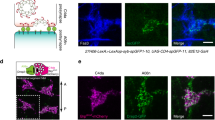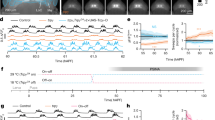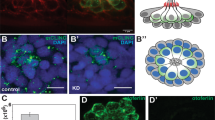Abstract
Large excitatory synapses with multiple active zones ensure reliable and fast information transfer at specific points in neuronal circuits. However, the mechanisms that determine synapse size in CNS circuits are largely unknown. Here we use the calyx of Held synapse, a major relay in the auditory system, to identify and study signaling pathways that specify large nerve terminal size and fast synaptic transmission. Using genome-wide screening, we identified bone morphogenetic proteins (BMPs) as candidate signaling molecules in the area of calyx synapses. Conditional deletion of BMP receptors in the auditory system of mice led to aberrations of synapse morphology and function specifically at the calyx of Held, with impaired nerve terminal growth, loss of monoinnervation and less mature transmitter release properties. Thus, BMP signaling specifies large and fast-transmitting synapses in the auditory system in a process that shares homologies with, but also extends beyond, retrograde BMP signaling at Drosophila neuromuscular synapses.
This is a preview of subscription content, access via your institution
Access options
Subscribe to this journal
Receive 12 print issues and online access
$209.00 per year
only $17.42 per issue
Buy this article
- Purchase on Springer Link
- Instant access to full article PDF
Prices may be subject to local taxes which are calculated during checkout








Similar content being viewed by others
Accession codes
References
Sanes, J.R. & Yamagata, M. Many paths to synaptic specificity. Annu. Rev. Cell Dev. Biol. 25, 161–195 (2009).
Walmsley, B., Alvarez, F.J. & Fyffe, R.E.W. Diversity of structure and function at mammalian central synapses. Trends Neurosci. 21, 81–88 (1998).
Sherman, S.M. & Guillery, R.W. On the actions that one nerve cell can have on another: distinguishing “drivers” from “modulators”. Proc. Natl. Acad. Sci. USA 95, 7121–7126 (1998).
Borst, J.G. & Soria van Hoeve, J. The calyx of held synapse: from model synapse to auditory relay. Annu. Rev. Physiol. 74, 199–224 (2012).
Sätzler, K. et al. Three-dimensional reconstruction of a calyx of Held and its postsynaptic principal neuron in the medial nucleus of the trapezoid body. J. Neurosci. 22, 10567–10579 (2002).
Bergsman, J.B., De Camilli, P. & McCormick, D.A. Multiple large inputs to principal cells in the mouse medial nucleus of the trapezoid body. J. Neurophysiol. 92, 545–552 (2004).
Rodríguez-Contreras, A., de Lange, R.P.J., Lucassen, P.J. & Borst, J.G.G. Branching of calyceal afferents during postnatal development in the rat auditory brainstem. J. Comp. Neurol. 496, 214–228 (2006).
Cant, N.B. & Benson, C.G. Parallel auditory pathways: projection patterns of the different neuronal populations in the dorsal and ventral cochlear nuclei. Brain Res. Bull. 60, 457–474 (2003).
Case, D.T., Zhao, X. & Gillespie, D.C. Functional refinement in the projection from ventral cochlear nucleus to lateral superior olive precedes hearing onset in rat. PLoS ONE 6, e20756 (2011).
Grothe, B., Pecka, M. & McAlpine, D. Mechanisms of sound localization in mammals. Physiol. Rev. 90, 983–1012 (2010).
Hoffpauir, B.K., Grimes, J.L., Mathers, P.H. & Spirou, G.A. Synaptogenesis of the calyx of Held: rapid onset of function and one-to-one morphological innervation. J. Neurosci. 26, 5511–5523 (2006).
Rodríguez-Contreras, A., van Hoeve, J.S., Habets, R.L., Locher, H. & Borst, J.G. Dynamic development of the calyx of Held synapse. Proc. Natl. Acad. Sci. USA 105, 5603–5608 (2008).
Hoffpauir, B.K., Kolson, D.R., Mathers, P.H. & Spirou, G.A. Maturation of synaptic partners: functional phenotype and synaptic organization tuned in synchrony. J. Physiol. (Lond.) 588, 4365–4385 (2010).
Erazo-Fischer, E., Striessnig, J. & Taschenberger, H. The role of physiological afferent nerve activity during in vivo maturation of the calyx of Held synapse. J. Neurosci. 27, 1725–1737 (2007).
Taschenberger, H. & von Gersdorff, H. Fine-tuning an auditory synapse for speed and fidelity: developmental changes in presynaptic waveform, EPSC kinetics, and synaptic plasticity. J. Neurosci. 20, 9162–9173 (2000).
Chuhma, N., Koyano, K. & Ohmori, H. Synchronisation of neurotransmitter release during postnatal development in a calyceal presynaptic terminal of rat. J. Physiol. (Lond.) 530, 93–104 (2001).
Futai, K., Okada, M., Matsuyama, K. & Takahashi, T. High-fidelity transmission acquired via a developmental decrease in NMDA receptor expression at an auditory synapse. J. Neurosci. 21, 3342–3349 (2001).
Koike-Tani, M., Saitoh, N. & Takahashi, T. Mechanisms underlying developmental speeding in AMPA-EPSC decay time at the calyx of Held. J. Neurosci. 25, 199–207 (2005).
Yang, Y.M. et al. GluA4 is indispensable for driving fast neurotransmission across a high-fidelity central synapse. J. Physiol. (Lond.) 589, 4209–4227 (2011).
Toyoshima, M. et al. Deficiency of neural recognition molecule NB-2 affects the development of glutamatergic auditory pathways from the ventral cochlear nucleus to the superior olivary complex in mouse. Dev. Biol. 336, 192–200 (2009).
Aberle, H. et al. Wishful thinking encodes a BMP type II receptor that regulates synaptic growth in Drosophila. Neuron 33, 545–558 (2002).
Marqués, G. et al. The Drosophila BMP type II receptor Wishful Thinking regulates neuromuscular synapse morphology and function. Neuron 33, 529–543 (2002).
McCabe, B.D. et al. The BMP homolog Gbb provides a retrograde signal that regulates synaptic growth at the Drosophila neuromuscular junction. Neuron 39, 241–254 (2003).
Miyazono, K., Kamiya, Y. & Morikawa, M. Bone morphogenetic protein receptors and signal transduction. J. Biochem. 147, 35–51 (2010).
Rawson, J.M., Lee, M., Kennedy, E.L. & Selleck, S.B. Drosophila neuromuscular synapse assembly and function require the TGF-β type I receptor saxophone and the transcription factor Mad. J. Neurobiol. 55, 134–150 (2003).
McCabe, B.D. et al. Highwire regulates presynaptic BMP signaling essential for synaptic growth. Neuron 41, 891–905 (2004).
Ball, R.W. et al. Retrograde BMP signaling controls synaptic growth at the NMJ by regulating trio expression in motor neurons. Neuron 66, 536–549 (2010).
Kalinovsky, A. et al. Development of axon-target specificity of ponto-cerebellar afferents. PLoS Biol. 9, e1001013 (2011).
Liem, K.F. Jr., Tremml, G., Roelink, H. & Jessell, T.M. Dorsal differentiation of neural plate cells induced by BMP-mediated signals from epidermal ectoderm. Cell 82, 969–979 (1995).
Zhang, D., Mehler, M.F., Song, Q. & Kessler, J.A. Development of bone morphogenetic protein receptors in the nervous system and possible roles in regulating trkC expression. J. Neurosci. 18, 3314–3326 (1998).
Bond, A.M., Bhalala, O.G. & Kessler, J.A. The dynamic role of bone morphogenetic proteins in neural stem cell fate and maturation. Dev. Neurobiol. 72, 1068–1084 (2012).
Graham, A., Francis-West, P., Brickell, P. & Lumsden, A. The signalling molecule BMP4 mediates apoptosis in the rhombencephalic neural crest. Nature 372, 684–686 (1994).
Augsburger, A., Schuchardt, A., Hoskins, S., Dodd, J. & Butler, S. BMPs as mediators of roof plate repulsion of commissural neurons. Neuron 24, 127–141 (1999).
Miyagi, M. et al. Bone morphogenetic protein receptor expressions in the adult rat brain. Neuroscience 176, 93–109 (2011); erratum 183, 278 (2011).
Carulli, D. et al. Composition of perineuronal nets in the adult rat cerebellum and the cellular origin of their components. J. Comp. Neurol. 494, 559–577 (2006).
Peterson, R.S. et al. CD44 modulates Smad1 activation in the BMP-7 signaling pathway. J. Cell Biol. 166, 1081–1091 (2004).
Mishina, Y., Hanks, M.C., Miura, S., Tallquist, M.D. & Behringer, R.R. Generation of Bmpr/Alk3 conditional knockout mice. Genesis 32, 69–72 (2002).
Voiculescu, O., Charnay, P. & Schneider-Maunoury, S. Expression pattern of a Krox-20/Cre knock-in allele in the developing hindbrain, bones, and peripheral nervous system. Genesis 26, 123–126 (2000).
Han, Y., Kaeser, P.S., Südhof, T.C. & Schneggenburger, R. RIM determines Ca2+ channel density and vesicle docking at the presynaptic active zone. Neuron 69, 304–316 (2011).
Yi, S.E., Daluiski, A., Pederson, R., Rosen, V. & Lyons, K.M. The type I BMP receptor BMPRIB is required for chondrogenesis in the mouse limb. Development 127, 621–630 (2000).
Schneggenburger, R., Meyer, A.C. & Neher, E. Released fraction and total size of a pool of immediately available transmitter quanta at a calyx synapse. Neuron 23, 399–409 (1999).
Denk, W. & Horstmann, H. Serial block-face scanning electron microscopy to reconstruct three-dimensional tissue nanostructure. PLoS Biol. 2, e329 (2004).
Kim, G. & Kandler, K. Elimination and strengthening of glycinergic/GABAergic connections during tonotopic map formation. Nat. Neurosci. 6, 282–290 (2003).
Koehl, A. et al. Gene expression profiling of the rat superior olivary complex using serial analysis of gene expression. Eur. J. Neurosci. 20, 3244–3258 (2004).
Friedland, D.R., Popper, P., Eernisse, R. & Cioffi, J.A. Differentially expressed genes in the rat cochlear nucleus. Neuroscience 142, 753–768 (2006).
Ji, S.J. & Jaffrey, S.R. Intra-axonal translation of SMAD1/5/8 mediates retrograde regulation of trigeminal ganglia subtype specification. Neuron 74, 95–107 (2012).
Foletta, V.C. et al. Direct signaling by the BMP type II receptor via the cytoskeletal regulator LIMK1. J. Cell Biol. 162, 1089–1098 (2003); erratum 163, 421 (2003).
Lee-Hoeflich, S.T. et al. Activation of LIMK1 by binding to the BMP receptor, BMPRII, regulates BMP-dependent dendritogenesis. EMBO J. 23, 4792–4801 (2004).
Eaton, B.A. & Davis, G.W. LIM Kinase1 controls synaptic stability downstream of the type II BMP receptor. Neuron 47, 695–708 (2005).
Ruediger, S. et al. Learning-related feedforward inhibitory connectivity growth required for memory precision. Nature 473, 514–518 (2011).
Farago, A.F., Awatramani, R.B. & Dymecki, S.M. Assembly of the brainstem cochlear nuclear complex is revealed by intersectional and subtractive genetic fate maps. Neuron 50, 205–218 (2006).
Renier, N. et al. Genetic dissection of the function of hindbrain axonal commissures. PLoS Biol. 8, e1000325 (2010).
Meyer, A.C., Neher, E. & Schneggenburger, R. Estimation of quantal size and number of functional active zones at the calyx of Held synapse by nonstationary EPSC variance analysis. J. Neurosci. 21, 7889–7900 (2001).
Xiao, L. et al. Developmental expression of Synaptotagmin isoforms in single calyx of Held-generating neurons. Mol. Cell Neurosci. 44, 374–385 (2010).
Knott, G.W., Quairiaux, C., Genoud, C. & Welker, E. Formation of dendritic spines with GABAergic synapses induced by whisker stimulation in adult mice. Neuron 34, 265–273 (2002).
Acknowledgements
We thank A. Grapin-Botton, E. Robertson, P. Scheiffele, M. Müller, O. Kochubey and D. Perkel for discussions, R. Behringer (University of Texas) and K. Lyons (University of California Los Angeles) for sharing mice, D. Constam (Ecole Polytechnique Fédérale de Lausanne) for providing ISH probes, H. Murray for expert technical assistance and O. Burri for help with image analysis. The cDNA array analyses were performed in the DNA array facility Lausanne (DAFL); image acquisition was done at the Bio-optical imaging platform of EPFL. The work was supported by the Swiss National Foundation Science (SNF; Sinergia CRSI33_127440/1), the National Center of Competence in Research of the SNF 'Synaptic Bases of Mental Disease', the Deutsche Forschungsgemeinschaft (DFG; PP 1608) (all to R.S.) and a Marie-Curie Fellowship (IEF-235223-CALYX MMFF; to N.M.).
Author information
Authors and Affiliations
Contributions
L.X. and R.S. conceived the study and designed experiments. L.X. performed electrophysiology, qPCR, ISH, IHC, TEM analysis and SBF-SEM reconstructions. N.M., E.K. and E.G. performed DNA array analyses, IHC and electrophysiology, and LSO electrophysiology, respectively. C.G. and G.K. performed SBF-SEM data acquisition and reconstruction. R.S. wrote the paper.
Corresponding author
Ethics declarations
Competing interests
The authors declare no competing financial interests.
Supplementary information
Supplementary Text and Figures
Supplementary Figures 1–5 and Supplementary Table 1 (PDF 1888 kb)
Supplementary Video 1
Video of a 3D-reconstructed MNTB neuron and its adjacent calyx synapse in a wild-type P8 mouse. Serial block face scanning EM (SBF-sEM) was used to reconstruct a single postsynaptic MNTB neuron and its adjacent synapses. The postsynaptic neuron is shown in gray; the adjacent excitatory nerve terminals are shown in color code according to their reconstructed volumes (green: 779 μm3; violet: < 10 μm3; see also color scale bar in Figure 5a. (MP4 1269 kb)
Supplementary Video 2
Video of a 3D-reconstructed MNTB neuron and its adjacent nerve terminals in a BMPR1a/1b cDKO mouse at P8. Serial block face scanning EM (SBF-sEM) was used to reconstruct several adjacent MNTB neurons, of which one is shown here. The postsynaptic neuron is shown in gray; the adjacent excitatory nerve terminals are shown in color code according to their reconstructed volumes (see color scale bar in Figure 5a). Note that in the BMPR1a/1b cDKO mice, several nerve terminals of intermediate size innervate a given MNTB neuron, suggesting that BMP signaling is involved in synapse elimination at the calyx of Held. (MP4 1624 kb)
Rights and permissions
About this article
Cite this article
Xiao, L., Michalski, N., Kronander, E. et al. BMP signaling specifies the development of a large and fast CNS synapse. Nat Neurosci 16, 856–864 (2013). https://doi.org/10.1038/nn.3414
Received:
Accepted:
Published:
Issue Date:
DOI: https://doi.org/10.1038/nn.3414
This article is cited by
-
Control of neuronal excitation–inhibition balance by BMP–SMAD1 signalling
Nature (2024)
-
Neurexin-3 subsynaptic densities are spatially distinct from Neurexin-1 and essential for excitatory synapse nanoscale organization in the hippocampus
Nature Communications (2023)
-
Long-term microglia depletion impairs synapse elimination and auditory brainstem function
Scientific Reports (2022)
-
LTP of inhibition at PV interneuron output synapses requires developmental BMP signaling
Scientific Reports (2020)
-
BMP-dependent synaptic development requires Abi-Abl-Rac signaling of BMP receptor macropinocytosis
Nature Communications (2019)



